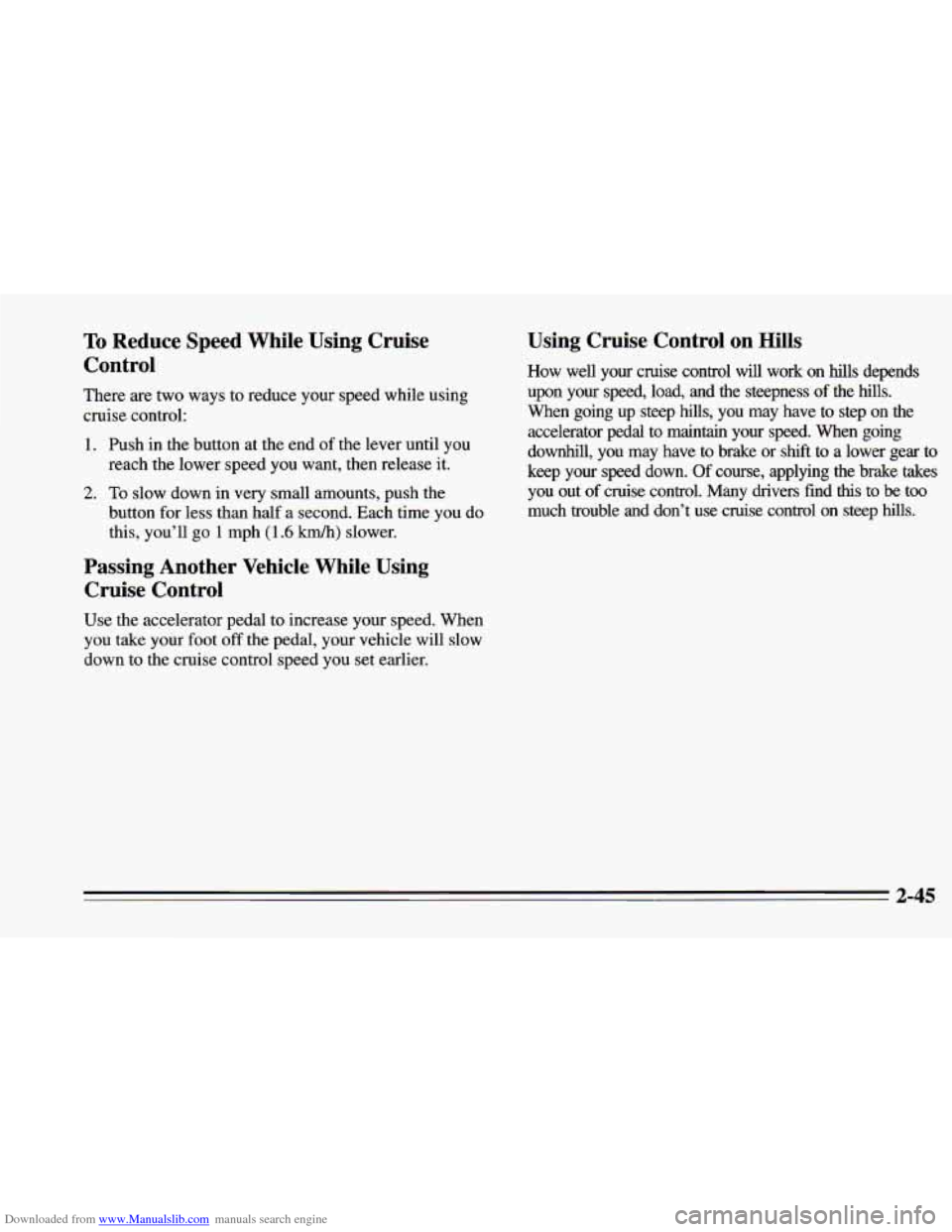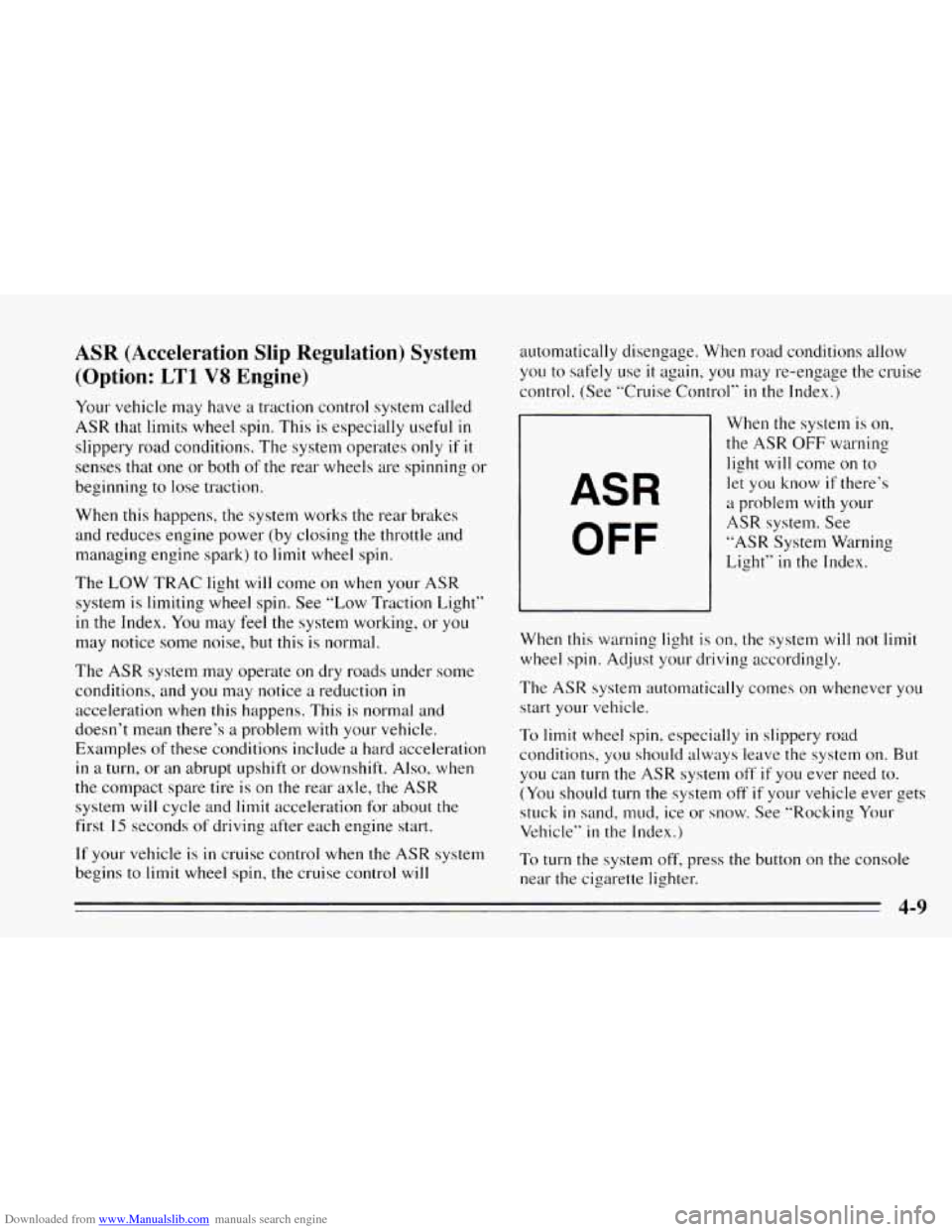Page 90 of 388
Downloaded from www.Manualslib.com manuals search engine The Turn SignaVHeadlamp Beam
Lever
The lever on the left side of the steering column
includes your:
0 Turn Signal and Lane Change Indicator
0 Headlamp High/Low Beam and Passing Signal
0 Windshield Wipers
0 Windshield Washer
0 Cruise Control (Option)
Turn Signal and Lane Change Indicator
a
The turn signal has two upward (for Right) and two
downward (for Left) positions. These positions allow
you to signal a turn or
a lane change.
To signal a turn, move the lever all the way up or down.
When the turn is finished, the lever will return
automatically.
2-38
Page 94 of 388
Downloaded from www.Manualslib.com manuals search engine Cruise Control (Option)
With cruise control, you can maintain a speed of about
25 mph (40 km/h) or more without keeping your foot on
the accelerator. This can really help on long trips. Cruise
control does not work at speeds below about
25 mph
(40 km/h).
When you apply your brakes, or push the clutch pedal, if
you have a manual transmission, the cruise control shuts
Off.
If your vehicle is in cruise control when the optional
ASR System begins to limit wheel spin, the cruise
control will automatically disengage. (See
“ASR
System’’ in the Index). When road conditions allow you
to safely use it again,
you may turn the cruise back on.
3 A3
Page 95 of 388
Downloaded from www.Manualslib.com manuals search engine To Set Cruise Control
1. Move the cruise control switch to ON
2. Get up to the speed you want.
3. Push in the set button at the end of the lever and
release it.
4. Take your foot off the accelerator pedal.
2-43
Page 96 of 388

Downloaded from www.Manualslib.com manuals search engine To Resume a Set Speed
Suppose you set your cruise control at a desired speed
and then you apply the brake or clutch pedal. This, of
course, shuts off the cruise control. But
you don’t need
to reset it. Once you’re going about 25 mph (40 km/h)
or more, you can move the cruise control switch from
ON to R/A (Resume/Accelerate) for about half a second.
You’ll
go right back up to your chosen speed and stay
there.
To Increase Speed While Using Cruise
Control
There are two ways to go to a higher speed. Here’s the
first:
1. Use the accelerator pedal to get to the higher speed.
2. Push the button at the end of the lever, then release
the button and the accelerator pedal. You’ll now
cruise at the higher speed.
Here’s the second way to go to a higher speed:
1. Move the Cruise switch from ON to WA. Hold it
there until you get up to the speed you want,
and
then release the switch.
2. To increase your speed in very small amounts, move
the switch to
R/A for less than half a second and then
release it. Each time you do this, your vehicle will
go
about 1 mph (1.6 kmh) faster.
2-44
Page 97 of 388

Downloaded from www.Manualslib.com manuals search engine To Reduce Speed While Using Cruise
Control
There are two ways to reduce ?bur speed while using
cruise control:
1. Push in the button at the end of the lever until you
reach the lower speed you want, then release it.
2. To slow down in very small amounts, push the
button for less than half a second. Each time you do
this, you’ll
go 1 mph (1.6 km/h) slower.
Passing Another Vehicle While Using
Cruise Control
Use the accelerator pedal to increase your speed. When
you take your foot off the pedal, your vehicle will slow
down to the cruise control speed you set earlier.
Using Cruise Control on Hills
How well your cruise control will work on hills depends
upon your speed, load, and the steepness
of the hills.
When going up steep hills, you may have to step on the
accelerator
pedal to maintain your speed. When going
downhill, you may have to brake or shift to a lower gear to
keep your speed down.
Of course, applying the brake takes
you out
of cruise control. Many drivers find this to be too
much trouble and don’t use cruise control on steep
hills.
2-45
Page 98 of 388
Downloaded from www.Manualslib.com manuals search engine To Get Out of Cruise Control
There are several ways to turn off the cruise control:
1. Step lightly on the brake pedal or push the clutch
pedal, if
you have a manual transmission; OR
2. Move the Cruise switch to OFF.
To Erase Speed Memory
When you turn off the cruise control or the ignition,
your cruise control
set speed memory is erased.
2-46
Page 165 of 388

Downloaded from www.Manualslib.com manuals search engine ASR (Acceleration Slip Regulation) System
(Option: LT1 VS Engine)
Your vehicle may have a traction control system called
ASR that limits wheel spin. This is especially useful in
slippery road conditions. The system operates only if it
senses that one or both of the rear wheels are spinning or
beginning to lose traction.
When this happens, the system works the rear brakes
and reduces engine power (by closing the throttle and
managing engine spark)
to limit wheel spin.
The
LOW TRAC light will come on when your ASR
system is limiting wheel spin, See “Low Traction Light”
in the Index. You may feel the system working, or you
may notice some noise, but this is normal.
The
ASR system may operate on dry roads under some
conditions, and you may notice a reduction
in
acceleration when this happens. This is normal and
doesn’t mean there’s a problem with your vehicle.
Examples of these conditions include
a hard acceleration
in a turn, or an abrupt upshift or downshift. Also, when
the compact spare tire
is on the rear axle, the ASR
system will cycle and limit acceleration for about the
first
15 seconds of driving after each engine start.
If your vehicle is in cruise control when the ASR system
begins to
limit wheel spin, the cruise control will automatically
disengage. When road conditions allow
you to safely use
it again, you may re-engage the cruise
control. (See “Cruise Control”
in the Index.)
ASR
OFF
When the system is on,
the ASR OFF warning
light will come on to
let you know
if there’s
a problem with your
ASR system. See
“ASR System Warning
Light’’
in the Index.
When
this warning light is on, the system will not limit
wheel spin. Adjust your driving accordingly.
The
ASR system automatically comes on whenever you
start your vehicle.
To limit wheel spin, especially in slippery road
conditions,
you should always leave the system on. But
you can
turn the ASR system off if you ever need to.
(You should
turn the system off if your vehicle ever gets
stuck
in sand, mud, ice or snow. See “Rocking Your
Vehicle”
in the Index.)
To turn the system off, press the button
on the console
near the cigarette lighter.
4-9
Page 303 of 388
Downloaded from www.Manualslib.com manuals search engine 1. ABS BAT Electronic Brake Control Module
2. FOG LTS: Fog Lamps
3. Not Used
4. Not Used
5. ABS IGN: Anti-Lock Brake System
6. FAN/ACTR: Coolant Fan Relays; EVAP Canister
Purge Solenoid; Exhaust Gas Recirculation; Low
Coolant Re1ay;Reverse Lockout Solenoid
7. AIR PUMP: Air Injection Pump Assembly; Air
8. PCM: Power Train Control Module
Pump
Relay
9. INJECTOR: Fuel Injectors
10. INJECTOR: Fuel Injectors
11. IGNITION: VIN Engine Code S: Camshaft Position
Sensor;Crankshaft Position Sensor; Electronic
Ignition Module VIN Engine Code P: Ignition Coil; Ignition Coil Driver
Cruise Control Switches and Module
12. A/C-CRUISE: Air Conditioning Compressor Relay;
Relays
B --Air Conditioning Compressor
C --Anti-Lock Brake System
D --Primary Coolant Fan (Driver Side)
E--Air Pump
F --Secondary Coolant Fan (Passenger Side)
G--ASR
H--Fog Lamps
J--Not Used
6-71